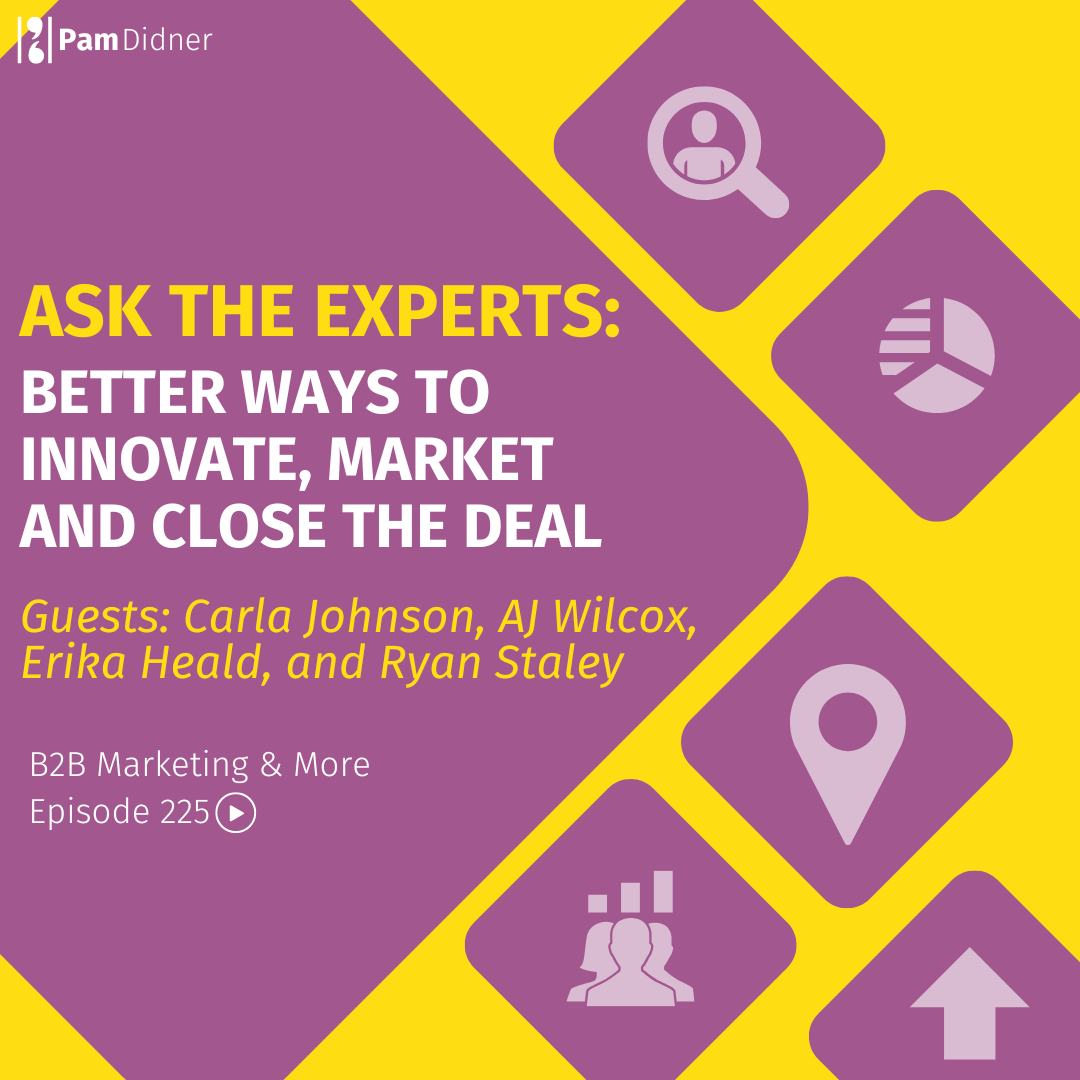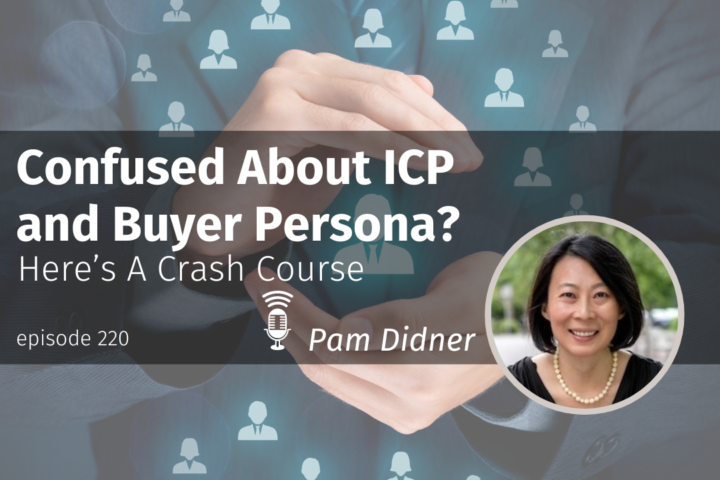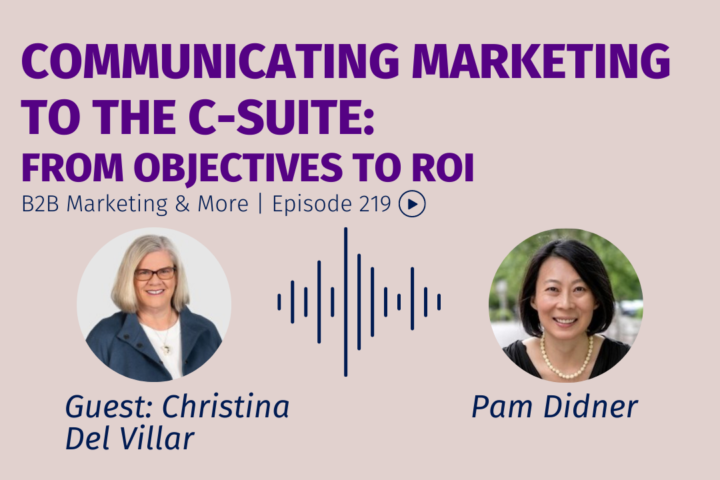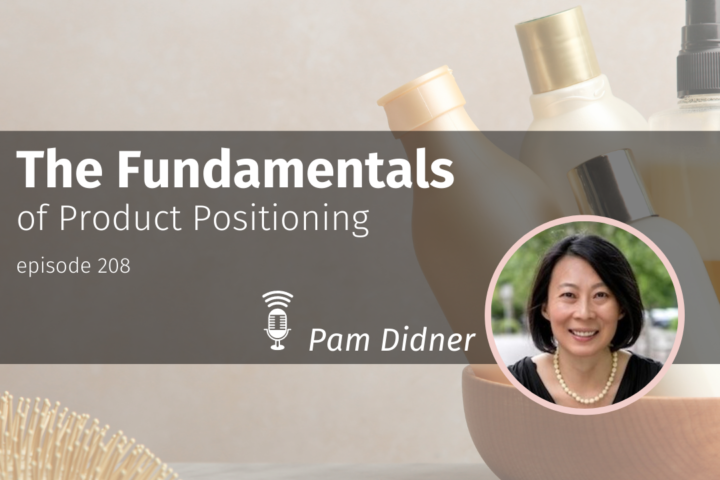
A big hello from Raleigh, North Carolina, and welcome to another B2B Marketing & More episode!
For this final episode of 2022, I will highlight some episodes I think are especially helpful for my B2B peeps and listeners. So let’s get started!
Since I love to travel, I thought I’d take you on a trip with me today. It’s a sales journey, but this includes some special stops. At each stop, an expert guest from this year will share tips and tricks to help you improve your sales and marketing chops and reach more ideal customers.
In this episode:
- Carla Johnson is a marketing and innovation strategist, keynote speaker, and author of ten books. In her latest book RE:Think Innovation, Carla breaks down the process that the world’s most prolific innovators use to consistently develop great ideas.
- AJ Wilcox specializes in paid ads for LinkedIn. AJ is a LinkedIn Ads Fanatic, host of The LinkedIn Ads Show, and founder of B2Linked, the Linkedin advertising agency.
- Ryan Staley is a sales professional, the CEO and the founder of Whale Boss. Ryan is a fantastic, high-performance salesperson who helps founders and revenue leaders implement 7 and 8 figure sales operating systems in less than three months.
- Erika Heald is a founder and the lead consultant at Erika Heald Marketing Consulting, Fractional Content Marketing Leader, and Executive Ghostwriter. Through her work, Erika helps many SaaS startups.
Quotes from the episode:
“The next step is to generate and generate ideas. So when Tim went to generate an idea for this product launch, he said, “how can we use humor to talk about something that everybody knows, but in a way that gets them to laugh and lower their emotional walls?” – Carla Johnson
“f the $300 in a month will give you a handful of clicks, you will not be any closer to finding out if it’s a channel that works. So, if you’re going to approach LinkedIn Ads, don’t do it with less than a $5,000 per month budget.” – AJ Wilcox
“We can physically talk to the people versus looking at and getting feedback from communities and social. You can talk to the people and ask them specific, tangible questions about the outcomes they want, what’s bothering them, and all those details.” – Ryan Staley
“Realistically, some of your best thought leaders will be those folks with deep subject matter experts who know a lot about your customers or who used to have jobs that are the same jobs that your ideal customers have.” – Erika Heald
—————
Enjoy the podcast? Subscribe to the show on your favorite podcast platform, leave a 5-star review and subscribe to Apple Podcasts.
If you prefer watching a video, I also have a YouTube Channel; check it out and subscribe.
If you want to chat, reach out to any social media channels or email me at hello@pamdidner.com. You can also join my Facebook community: Build Your Marketing Skills to Get Ahead. When you join, you get a free Starbucks on me. You can go to the Announcement tab and click on the barcode of the gift card.
To expand your knowledge and explore more expert tips on innovating, marketing and closing deals, check out some of my previous podcast episodes, blog posts, and videos.
Podcast episodes
Rethinking Newsletters with Ann Handley
Communicating Marketing to the C-Suite: From Objectives to ROI
Where Marketers Can Better Help Sales Boost Revenue
Blog post
How To Develop Buyer Personas: A Crash Course
AI for Sales and Marketing: Q&A with Streamly
Video
3 Creative Ways Marketing Can Support Sales
TRANSCRIPT
A big hello from Raleigh, North Carolina, and welcome to another B2B Marketing & More episode! I’m Pam Didner. What can I say about 2022? I can sum it up in one word: Great!
The great pandemic, the great resignation, the great relocation, the great retirement, and the great stock market crash. Somehow, all of that led to the great reshuffling of our lives. It was exhaustingly great.
I moved from the West Coast to the East Coast! I need to do an episode of my experience living in North Carolina one of these days. If you are a listener and a native of North Carolina, reach out and talk to me about North Carolina. I’d love to learn about and understand this state a lot more. One of my 2023 new resolutions is to drive around North Carolina, Charlotte, the Outer Banks, Asheville, the Blue Ridge Mountains and more. I can’t wait!!
We all agree that we somehow go back to a sense of normality in 2nd half of the year. I was on the road for eight weeks from September to December, speaking at the conference, visiting clients and seeing friends and colleagues in different cities. Love to see people in Zoom, but hugging people in person is lovely! If you’re not a hugger, I completely understand. But it’s also been wonderful to continue having thoughtful and inspiring conversations here on the podcast.
For this final episode of 2022, I will highlight some episodes I think are especially helpful for my B2B peeps and listeners. So let’s get started!
As I mentioned earlier, I love to travel. So I thought today I’d take you on a trip with me. It’s a sales journey, but this includes some special stops. At each stop, an expert guest from the past year will share tips and tricks to help you improve your sales and marketing chops and reach more ideal customers.
This journey begins with a conversation with Carla Johnson back in February. Carla is a marketing and innovation strategist, keynote and author. For her book REThink: Innovation, Carla interviewed her clients to discover how innovation happens and can continue. What she found boiled down to the five steps of what she calls the “Perpetual Innovation Process.” The steps are observed, distil, relate, generate and pitch.
What I loved about our conversation was that Carla has found a way to demystify innovation. It’s not solely about geniuses coming up with ideas no one has ever heard of. Everyone, I mean everyone, is capable of innovating, says Carla, and they can learn from other industries. Like, how McDonald’s studied Formula 1 pit crews to help their drive-thru teams work better and faster.
Carla shared another example from the B2B world:
Carla Johnson: – I have a great friend named Tim Washer, and Tim is a comedian. And he’s worked with some of the best Conan O’Brien. He was a writer for Amy Poehler on Saturday Night Live Weekend Update, you know, that level of a comedian. So he worked, he was a Creative Director at Cisco. And he had a new product launch to do. And you know, like a technology company, you don’t think of them as doing amazingly creative and innovative product launches. It’s usually an executive or an engineer talking about, you know, the features and all of the new things that customers can do because of this product.
But Tim said, “let’s do something different and innovative.” Then he happened to be in a comedy club in New York City one night, and the comedian Ray Romano was on stage and Tim kind of sat back in his chair. He observed the audience, not just Ray as a comedian and a performer. But he said, as he watched it, he observed how Ray moved on the stage. He observed the body responses and how people began to lean in as Ray went through his routine. Ray talked about things like family, in-laws, kids, and all of these things that people could relate to in a short amount of time, but all through humor.
And as Ray got people to laugh in the audience, everybody’s emotional wall started to go down.
As Tim looked at all of these things he observed, he distilled that into patterns. Patterns of being able to build relationships very quickly with people that most likely Ray didn’t know and then talking about very familiar things. Doing it with humor. And this laughter got people to lower their emotional walls and be willing to hear things they normally wouldn’t hear. So it was those patterns that he related to his work.
Now the next step is to generate and generate ideas. So when Tim went to generate an idea for this product launch, he said, “how can we use humor to talk about something that everybody knows, but in a way that gets them to laugh and lower their emotional walls?” And that’s how he used humor to do a video for the product launch, which happened to come out right around Valentine’s Day. Instead of having an engineer talk about how fantastic the ASR 9000 router is, he made it into a Valentine’s Day video about the ASR 9000 router being the perfect Valentine’s Day gift. And you think about putting this router up there with diamonds, jewelry, and flowers….
Pam Didner: It certainly stands out (laughs)!
Carla Johnson: Exactly, but because he could tell the story of what he observed, the patterns he noticed, how that related to the work, how that generated his idea, that was his pitch. The pitch is to go back and walk through each of these steps, and you have a natural story structure.
That’s Carla Johnson. Love her! Check out the full episode to learn more about innovation and how teams can move on if they get stuck in the process. I’ll put a link in the show notes.
So, building off my conversation with Carla, let’s say your company has come up with a fantastic product, service or upgrade. Your marketing time has come with great messaging, collateral, and a plan. Now, it’s time to get the word out and sell it to your customers.
In today’s marketing world, digital ads are a big part of advertising. Of course, there are many options: FaceBook, Instagram, and Twitter. You name it. In June, I reached out to AJ Wilcox to talk about his specialty: LinkedIn ads. He told me he likes LinkedIn because you can target your pay ads to people with specific job titles, at specific companies, and in specific regions. That means you can target your ideal customer.
But when AJ and I spoke, we agreed that’s only one part of the equation.
Paid ads (on ANY platform) campaigns must also be set up to help you learn more about customers. So that means avoiding one-and-done ad campaigns.
AJ Wilcox: It’s really important on any channel to ensure that you generate enough data to tell whether or not something’s working. And if you go in and spend the very minimum that you can on LinkedIn, which is $10 a day…
Pam Didner: Don’t bother.
AJ Wilcox: If the $300 in a month will give you a handful of clicks, you will not be any closer to finding out if it’s a channel that works. So, if you’re going to approach LinkedIn Ads, don’t do it with less than a $5,000 per month budget. And so many small businesses can still afford that, but I’m assuming some listeners will be like, “Man, I don’t have that.” So if that’s your case, as well, what I would recommend is just make sure that you are set to spend $5,000 before you shut it off. So if your budget is only $1,500 a month, great. Just make sure you are running it for at least three months before you decide to cut it or increase it.
Pam Didner: The other question I want to ask is on top of that,t as well. If you do have $5,000, how long should you run? Of course, you’ll say as long as possible, but minimal level?
AJ Wilcox: Yeah, for me, advertising is very much a linear process. You’re going to spend money; you’re going to get impressions. And then those impressions are going to turn into clicks. And then, a certain percentage of those clicks will turn into conversions. And then, a certain number of those conversions can become sales-qualified or marketing-qualified leads. A certain percentage of…
I’m preaching to the choir here, but for me, it depends on what level of surety, the level of confidence you want.
Pam Didner: Got it.
AJ Wilcox: If you just want to find out, what is my cost per lead from this channel going to be? Yeah, you could spend for two or three months and go, “Oh, looks like my cost per lead is— .”
Pam Didner: Okay. I got some baseline. Yeah.
AJ Wilcox: Yeah, exactly. But if your goal is to find out my ROI from LinkedIn Ads?
Yeah, you’re going to have to look at how long my sales cycle is and how long it takes us to nurture these leads to close. And maybe you’ll be in this for two, three, four years before you have statistical significance around that data. So it is up to you, but if you are running against Facebook ads, hands down, Facebook ads will always be a lower cost per lead because the cost per click is cheaper.
But when you follow that into your CRM, you look further down the sales cycle. You’re going to find that, wow, because LinkedIn’s targeting was so good at getting the right people, even though we’re paying more for it, by the time you’re looking at your cost per sales qualified lead, or your cost per proposal sent, or your cost per closed deal, all of a sudden LinkedIn looks good compared to Facebook. But so many people were scared off by it because of the initial high costs that they never gave it a real chance.
I was speaking with AJ Wilcox, who specializes in running LinkedIn pay ads. He also shared some dos and don’ts about setting up campaigns on LinkedIn, so be sure and check out the full episode.
As we continue on this year-end B2B Marketing & More episode, let’s continue on our journey to sales! You know I’m all about effective Sales Enablement and helping sales and marketing teams work together. Having worked alongside the sales teams for many years, I know they face some particular challenges—especially if they’re tasked to bring in more contracts.
So back in March, I checked in with Ryan Staley, a long-time sales professional and the CEO and founder of Whale Boss, to talk about what it takes to land a deal. In the conversation, I asked him about common mistakes sales teams make when approaching a potential customer.
Ryan Staley: One of the things that many companies focus on are sales reps or sales leaders is like, “Hey, the ROI for the company is this. They’re going to save millions of dollars to do this.” But one of the things that they forget is, okay, how is that person evaluated? What kind of KPIs are they evaluated with? You know, at the end of the year, when they sit down with their boss and you’ve just finished, are they going to get a bonus or are they going to get demoted? And did they hit on what they were supposed to? So that’s the tangible business side of it.
But then also it’s like, what is that solution going to do emotionally for that person you’re selling to?
Because logic is how people make decisions. Emotion is what creates action. And so those two kinds of triggers are key things to look at when you’re trying to work and sell. So I would say that’s number one. Number two is just asking good questions. Okay? That’s one of the advantages that sales have over marketing.
We can physically talk to the people versus looking at and getting feedback from communities and social. You can talk to the people and ask them specific, tangible questions about their desired outcomes, what’s bothering them, and all those details. So I would say just being a ninja at asking good thought-provoking questions that make people question thoughts that they previously had.
Pam Didner: So what if you’re trying for a corporate client and you can’t get in there for the one-on-one to ask questions? and have to go in cold?
Ryan Staley: So there was a deal that my team was working on, and the reps were full cycle. And so they had a prospect. Um, they didn’t have an SDR team, or we didn’t have any marketing support. So they had to find a way to get into these big Fortune 1000 and Fortune 500 companies. One of the companies trying to get into was Walgreens, which is like Fortune 10. So they’re even bigger than big. Right?
Well, what happened was Walgreens recently merged with Boots–this was maybe four years back. They just merged with Boots, and their CEO and chairman identified in their press release that one of the first priorities and outcomes of the merger is to gain quote-unquote “synergies”,; where they’re going to get $500 million in synergies from merging the companies. And what they were saying is they’re taking $500 million out of business in costs. One of the levers we hit on to get in there was to link to that initiative that the CEO was talking about.
Pam Didner: Because it’s top down, it’s coming from the management. It’s top-down.
Ryan Staley: Exactly, exactly. And so, that’s a good example of how to hit on that. You could look at 10 K’s. You could look at other financials if you want; the letter to the CEO in the annual report is great. That doesn’t scale for small-to-medium-sized companies, but for big, big deals, that’s what I would recommend.
Ryan Staley is the founder and CEO of Whale Boss. When we spoke, he also shared ways to develop rapport quickly with a potential client, so check out the full episode.
Connecting to potential clients through a sales team is one way to reach new customers or re-establish past relationships. Still, another approach I like is marketing through thought leadership. It may not be as direct and immediate as pay ads, but it’s a long play which is sensible with B2B companies with a long purchase cycle. Use content to influence your customer’s points of view about specific products or technologies.
When I thought about addressing this topic in the podcast, I knew I had to talk with Erika Heald.
She’s a founder and the lead consultant at Erica Heald Marketing Consulting, where she helps SaaS startups, specialty food companies, and many others. She told me, too often, thought leadership can feel like a “one-way blast of information coming from a brand.”
Erika Heald: For me, thought leadership is when you’re regularly putting those unique perspectives from leaders within your company out there in public through various types of content. So it can be everything from blog posts to eBooks to public speaking engagements, podcasts, all of these different avenues.
But the key is people who are subject matter experts and have a point of view. And this is for me where I see the biggest kind of issues come up because frequently–and not to disparage PR agencies. Frequently you will see thought leadership as a few slides in a PR presentation, as you know, “oh, hey, so for this month, here’s the thought leadership”, and it’s a couple of catchy headlines with your CEO’s picture next to it.
And it’s like, “well, that’s all great, but they’re not necessarily thought leadership.”
They’re often tied into the PR campaign or what have you. Still, they’re not focused on that human being and their experiences and sharing them with people in a meaningful way. And from my perspective, you have to have that involvement with that thought leader and have that unique perspective and point of view that they’re willing to share. If they’re gonna tell you everything you already read in HBR that month, that will not work because people want something authentic.
Pam Didner: If they know a specific topic or field very well, they can help other people learn or provide some insights that other companies or competitors cannot provide. That’s also a sense of thought leadership. Is that correct?
Erika Heald: 100%. You know, thought leadership is not limited to your C-suite. Suppose you’re only putting your CEO out there or the other folks who sit on that same floor–you know if you have a physical headquarters anymore. Realistically, some of your best thought leaders will be those folks with deep subject matter experts who know a lot about your customers or who used to have jobs that are the same as your ideal customers. They will be those who deeply feel the pain and challenges your customers have every day. Those folks will be fantastic thought leaders and have much to offer. So I encourage folks to look a little bit more widely at who could be part of their thought leadership programs.
That was Erika Heald. Erika has some good tips in this episode if you struggle to identify thought leaders.
We also talked about how to juggle when multiple teams play a role in communicating thought leadership. That’s a tricky one, so check out the full episode.
And again, links for all the episodes I featured today are in the show notes.
Thanks for taking this journey with me today. These experts have fantastic tips and tricks to help you and your company innovate, advertise, sell and educate. I’m always here if you have questions about B2B sales and marketing, so don’t hesitate to reach out. Happy Holidays and see you on the other side in 2023. Take care. Bye!



